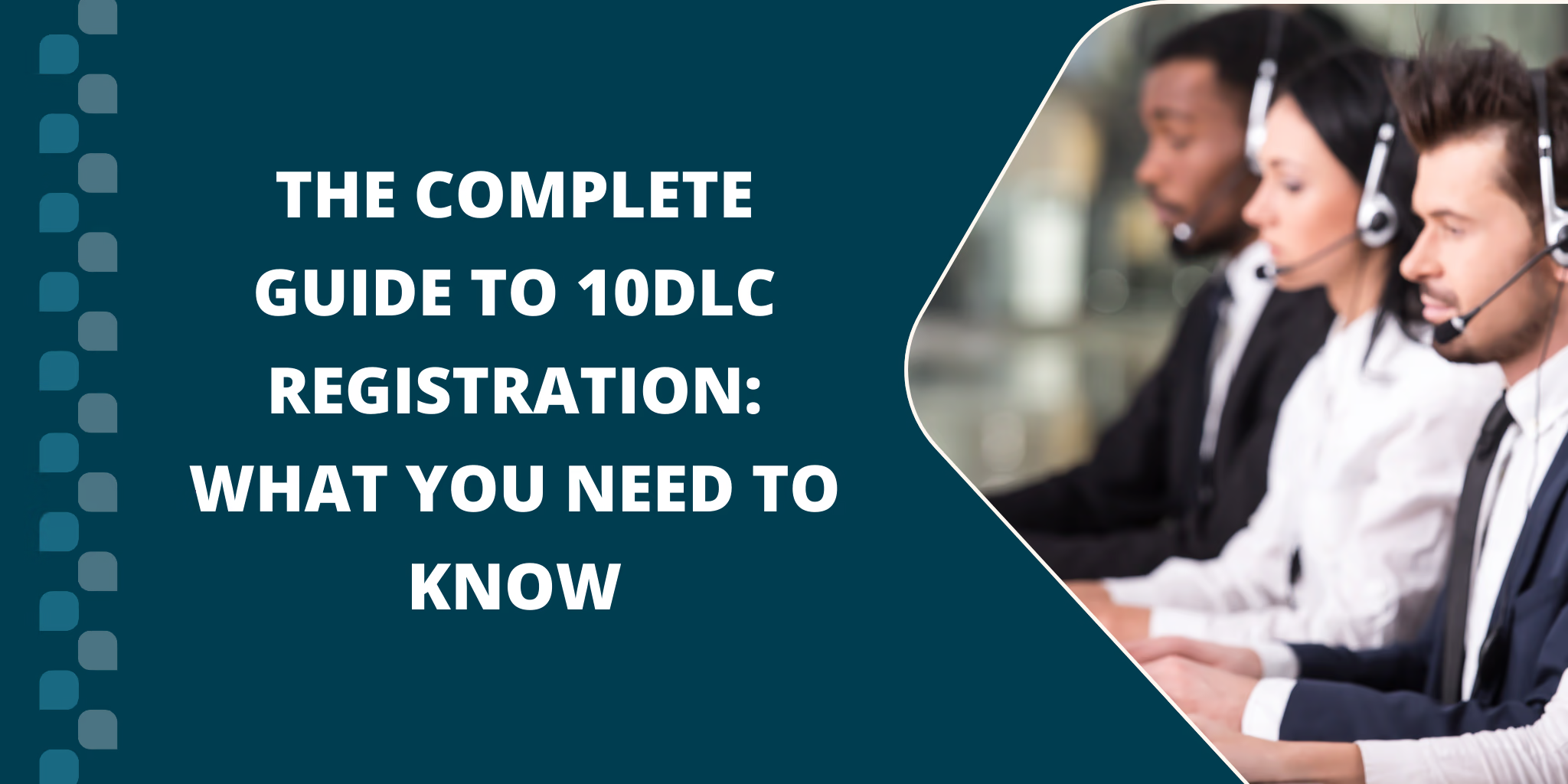Text messaging is one of the most effective ways to connect with customers, and 10DLC (10-Digit Long Code) is quickly becoming the standard for business texting. In case you’re unfamiliar, 10DLC was created by mobile carriers to help legitimate businesses reach their audiences reliably, while reducing spam and fraudulent messaging. This guide will walk you through the 10DLC registration process, offer tips to avoid common mistakes, and help you adopt best practices so your messages stay compliant-and actually get delivered.
For many small to mid-sized businesses, 10DLC hits the sweet spot, balancing volume, cost, and that friendly “local” vibe. If you absolutely need lightning-fast, large-scale messaging (like for big voting campaigns or national promotions), a short code might be worth the investment. Toll-free can also work if your brand identity is already tied to an 800 number, or if you prefer a single line for calls and texts.
Key Insight: 10DLC registration ensures your business messages are delivered reliably while keeping you compliant with carrier regulations.
Why 10DLC Matters
Before we dive in, let’s clarify why 10DLC is such a big deal. Whenever you send a text message to a customer from an application (like your CRM or scheduling platform), it’s classified as A2P messaging (application-to-person). Today’s carriers want all A2P messages using local 10-digit numbers to be registered, so they can verify who’s sending these texts and cut down on unwanted spam. If your business texts are not registered, they’re likely to get blocked or heavily filtered. Think of 10DLC as a way to show the carriers you’re playing by the rules. Once you’re registered, your texts come from a “vetted” source, which means better deliverability. Plus, you’ll avoid potential fines that carriers charge for non-compliant messaging. In short, 10DLC is your ticket to sending text messages legitimately and effectively.Step-by-Step 10DLC Registration Process
Ready to get started? Here’s the basic process for registering your business for 10DLC.Registration Tip: Double-check your business information before submission to avoid delays in the verification process.
1. Gather Your Business Information
You’ll need:- Legal business name (exactly as it appears on your official documents)
- Physical address
- EIN (Tax ID) or other approved identifier
- Active business website (which shows you’re legitimate)
- Business email (ideally not a free email like Gmail)
2. Register Your Brand
Next, you or your messaging provider submits your brand details to The Campaign Registry (TCR). TCR acts as the central database that all U.S. carriers consult. Once approved, you’ll get a Brand ID that’s unique to your business. This step is usually handled behind the scenes by your texting platform or a Campaign Service Provider (CSP). Just confirm that all the info you provided is accurate.3. Register Your Campaign(s)
After your brand is in TCR, you’ll register each campaign, which is basically the type of texting you plan to do. A campaign might be for marketing promotions, appointment reminders, two-factor authentication, and so on. For each campaign, you’ll submit:- Campaign name and description
- Sample messages (so carriers know what you’ll be sending)
- Opt-in method (how customers give consent)
- Opt-out instructions (e.g., “Reply STOP to unsubscribe”)
- Anticipated text volume and frequency
4. Assign a 10DLC Number
Once your campaign is approved, you’ll link the campaign to a 10-digit phone number. This could be a brand-new number or an existing one your business already uses. Each number must be tied to a specific campaign. If you use multiple numbers (for different departments or locations), each one will need a separate registration.5. Complete Registration and Test
After your brand and campaign are approved and you’ve assigned a number, congratulations-you’re officially registered! It typically takes a few days to a couple of weeks, depending on how many manual reviews are needed. At that point, test by sending a few texts to confirm they’re delivered without issues. Once you start sending messages, stick to the content and volume you promised during registration for best results. Note on Fees: There are usually fees for brand and campaign registration, plus small monthly charges. Your messaging provider will pass these costs along to you. It might feel like an extra step, but unregistered messages can be blocked or even fined, so the cost is worth avoiding bigger headaches later.Compliance Best Practices for 10DLC
Registering is only half the battle. To keep things running smoothly, you also need to follow ongoing compliance rules. Here’s what carriers and the CTIA (Cellular Telecommunications Industry Association) expect:1. Secure Proper Consent
Opt-in is a must. You can only text individuals who’ve explicitly agreed to receive messages from you. Acceptable opt-in methods include online signup forms with a checkbox for SMS consent, a text-in keyword, or a verbal agreement you document. Avoid purchased lists-it’s a fast track to getting flagged.2. Keep Opt-Out Simple
Recipients must be able to unsubscribe easily. If someone texts “STOP,” you have to stop sending. Your texting platform should handle this automatically, but it’s good practice to remind users occasionally that they can text STOP to opt out.3. Watch Your Content
Carriers forbid certain content, often summarized by the acronym SHAFT (Sex, Hate, Alcohol, Firearms, Tobacco), along with anything illegal, harassing, or deceptive. Even if something is legal in your state (like cannabis), carriers may still disallow it because it’s not federally legal. Stick to what you declared in your campaign description, and don’t send spammy messages like “FREE $$$” or suspicious links that might look like scams.4. Identify Yourself
Include your business name or a clear identifier in each text. Never assume the customer will recognize your number-it’s good manners and sometimes a requirement. A quick “Hi from [Company Name]” goes a long way toward building trust.5. Manage Frequency and Throughput
You’ll have a limit on how many texts you can send per minute, day, or month. Exceeding your approved volume can trigger spam filters. If you need higher throughput, talk to your provider about increasing your “trust score.”6. Keep Everything Current
If your business model changes or you add new messaging campaigns, update your 10DLC registration. Don’t just start sending totally new types of texts under an old campaign-carriers can flag that as suspicious.7. Document Consent and Activity
Be prepared to prove you followed the rules if a carrier or regulator ever audits you. Keep records of when and how each contact opted in, plus your message logs. This practice helps protect you if any complaints come up later. Following these guidelines isn’t just about avoiding trouble-it also improves deliverability and boosts customer trust.Common Pitfalls (and How to Avoid Them)
Even well-meaning businesses can slip up. Here are a few pitfalls to watch out for:- Skipping Registration: It might be tempting if you send only a handful of texts, but carriers now block or filter unregistered traffic. Always register.
- Providing Incorrect Info: Inconsistent details (like an address that doesn’t match public records) can lead to rejections. Double-check your submission before hitting “send.”
- Weak Opt-In Proof: Carriers want to see exactly how you collected consent. If your website or forms don’t mention SMS, your campaign can be rejected.
- No Opt-Out Reminders: Failing to include “Reply STOP to unsubscribe” can annoy recipients and raise red flags.
- Sending Disallowed Content: A single prohibited message can get your campaign suspended. If your industry deals with sensitive or age-restricted material, proceed cautiously.
- Ignoring Your Volume Limits: Sending huge blasts beyond your approved thresholds will likely get your messages flagged as spam.
- Not Updating Campaigns Over Time: If you pivot your business or expand your use cases, register new campaigns or update your existing ones.
- Forgetting to Monitor Performance: Watch out for spikes in opt-outs or drop-offs in delivery-these can signal compliance or content issues.
Industry-Specific Use Cases
Wondering if 10DLC is right for your industry? Here’s how a few sectors benefit:Healthcare
Hospitals, clinics, and dental practices use 10DLC for appointment reminders, prescription notifications, and follow-up care. They keep messages high-level to avoid sharing sensitive health info, and they get patient consent during intake forms. HIPAA regulations still apply, so stay cautious with personal data.Finance
Banks and insurers rely on text alerts for things like transaction or fraud notifications, payment reminders, or security codes (2FA). Users usually opt in via their account preferences, ensuring a clear trail of consent. Quick, secure messaging also builds trust with customers.Retail & eCommerce
Retailers see big engagement with promotional texts-flash sales, loyalty rewards, back-in-stock alerts, and so on. They just have to make sure every subscriber has clearly opted in for marketing messages. Texting from a local number helps personalize the experience, and 10DLC’s better throughput means marketing blasts won’t get throttled as often. Other sectors-from real estate to education to non-profits-use 10DLC in similar ways. As long as you have express consent and follow your registered use case, you can get creative with how you keep customers informed.10DLC vs. Toll-Free vs. Short Codes
10DLC (Local 10-Digit Numbers)- Pros: Looks local, good for moderate-to-high volume, can handle voice and text, affordable.
- Cons: Has registration fees, some throughput limits, mainly for U.S. and Canada.
- Pros: One number for calls and texts, strong recognition, verification process is generally simpler than short codes, and texts to a toll-free number are free for recipients.
- Cons: Doesn’t look local, can have throughput limits, still requires compliance.
- Pros: Very high throughput (hundreds of texts per second), ideal for massive campaigns, excellent deliverability.
- Cons: Expensive (thousands per month), lengthy approval process, not voice-capable, less personal feel.
| Type | Pros | Cons |
|---|---|---|
| 10DLC (Local 10-Digit Numbers) | Looks local, good for moderate-to-high volume, can handle voice and text, affordable. | Registration fees, throughput limits, mainly for U.S. and Canada. |
| Toll-Free Numbers (e.g., 1-800) | One number for calls and texts, strong recognition, simpler verification, free texts for recipients. | Doesn’t look local, throughput limits, requires compliance. |
| Short Codes (5-6 digits) | Very high throughput, ideal for massive campaigns, excellent deliverability. | Expensive, lengthy approval process, not voice-capable, less personal feel. |



